African art is a vast and diverse category that includes traditional art forms such as sculptures, masks, and textiles, as well as contemporary forms like photography and video art. The art is created by different ethnic groups across the continent of Africa, each with its own unique cultural and historical significance. In this article, we will provide a brief overview of African art and discuss the importance of understanding its historical and cultural significance.
Brief Overview of African Art
African art can be traced back to prehistoric times, with rock paintings and engravings found in different regions of Africa. Traditional African art forms include sculpture, masks, textiles, pottery, and beadwork. These art forms are often linked to religious and cultural practices and are used in rituals, ceremonies, and everyday life.
One of the most iconic forms of African art is the African mask, which is used in many different contexts. Masks are used in initiation ceremonies, funerals, and other cultural events. They are often considered to be a bridge between the spiritual and physical worlds, and the designs and colors used in masks can vary depending on their intended use.
Another significant art form in Africa is sculpture. Sculptures are often created to depict religious or cultural figures, and they can be made from a variety of materials such as wood, stone, and metal. Sculptures can range in size from small figurines to large statues, and they are often displayed in public spaces or used in religious rituals.
Importance of Understanding Historical and Cultural Significance
Understanding the historical and cultural significance of African art is crucial for several reasons. Firstly, African art is a reflection of the diverse cultural heritage of the continent. Each ethnic group has its own unique traditions, beliefs, and values, and these are often reflected in the art forms they create.
Secondly, African art provides insights into the religious and spiritual beliefs of different African societies. Many African art forms are linked to religious practices, and understanding the symbolism and meaning behind these art forms can help us gain a deeper appreciation of African spirituality.
Thirdly, African art is an important part of African history. Many African societies did not have a written history, and their stories and traditions were passed down through oral traditions. Art forms such as sculptures and masks were often used to convey important historical events, and studying these art forms can help us gain a better understanding of African history.
Finally, understanding the historical and cultural significance of African art can help us challenge stereotypes and misconceptions about Africa. For too long, Africa has been portrayed as a continent of poverty and war, and its rich cultural heritage has often been overlooked. By studying African art, we can challenge these stereotypes and gain a better understanding of the complex and diverse continent of Africa.
African art is a vast and diverse category that encompasses a wide range of traditional and contemporary art forms. Understanding the historical and cultural significance of African art is crucial for gaining a deeper appreciation of African culture, religion, and history. By studying African art, we can challenge stereotypes and gain a better understanding of the diverse continent of Africa.
Forms of African Art
African art is rich and diverse, spanning a wide range of mediums and forms. These forms are deeply rooted in African culture and are a reflection of the continent's diverse and complex history. Here are some of the most prominent forms of African art: VIEW WORKS FOR SOME OF THE BEST AFRICAN ARTIST.
AFRICAN SCULPTURE
Sculpture is one of the most well-known forms of African art. It is created using a variety of materials such as wood, metal, and stone. African sculptures are often characterized by their stylized and abstract forms. They often depict figures, animals, or abstract shapes and are used in a variety of cultural and religious contexts.

Dr Oku Ampofo working on a sculpture.
AFRICAN PAINTING
African painting is another popular form of art that varies greatly from region to region. Some paintings are created on walls or cave surfaces, while others are done on canvas or paper. African painters often use bright colors and bold designs to depict everyday life, cultural events, and historical moments.
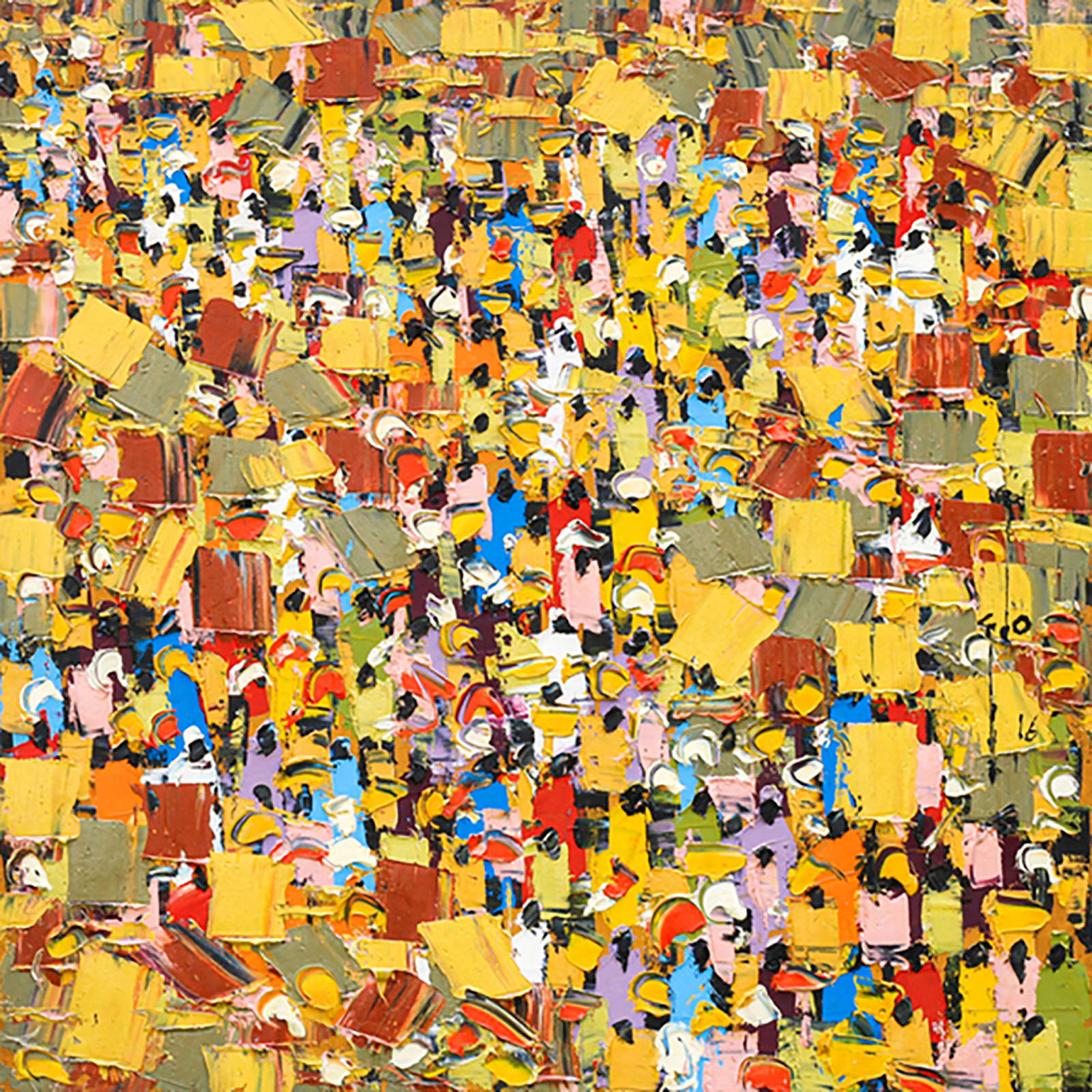
Ablade Glover - Open Market - Oil - 76.2x76 inches
AFRICAN POTTERY
Pottery is another important form of African art that has been practiced for centuries. African pottery is known for its intricate designs and patterns, which are often influenced by the natural world. It is used in a variety of contexts, from cooking to religious ceremonies.
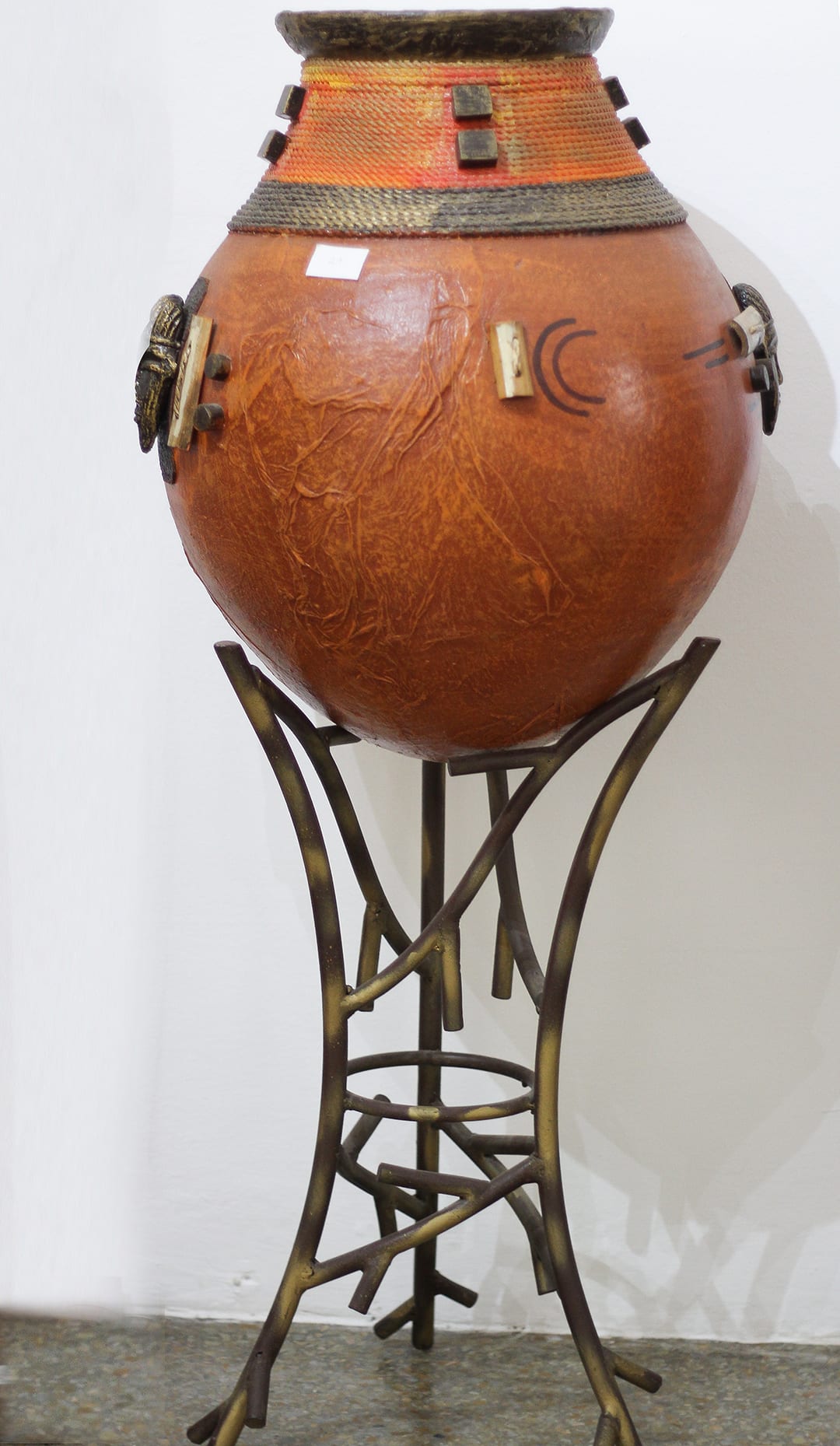
AFRICAN ROCK ART
Rock art is a form of African art that involves creating designs and images on natural rock surfaces. This form of art has been practiced for thousands of years and is still practiced in some regions of Africa today. Rock art often depicts animals, people, and other objects, and is used to communicate cultural and religious ideas.
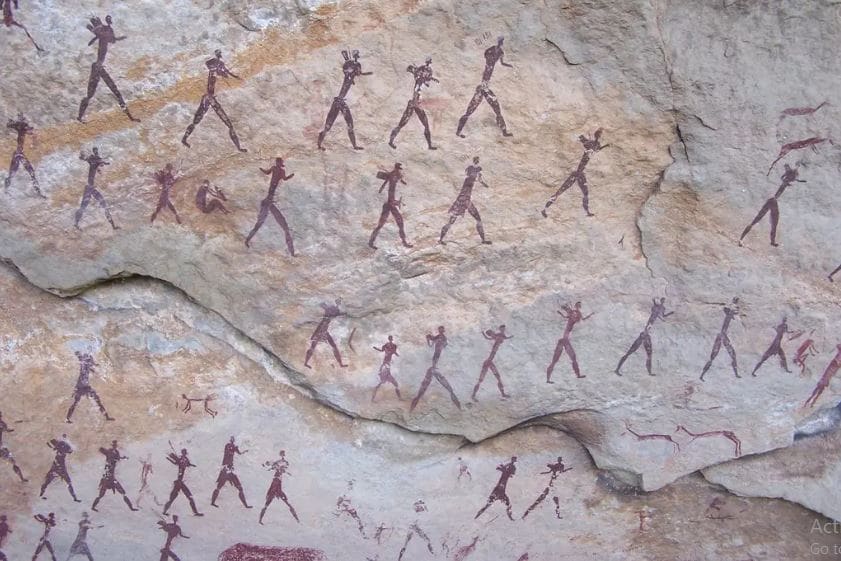
Photo by: Discover Africa
AFRICAN TEXTILES
Textiles are an important form of African art that are used for a variety of purposes. They are often used to create clothing, blankets, and other items, and are characterized by their bright colors and intricate designs. African textiles often incorporate cultural and religious symbols and are used to communicate social status and identity.
AFRICAN MASKS
Masks are an important part of African art and are used in a variety of cultural and religious contexts. They are often used in initiation ceremonies, funerals, and other important events. African masks are known for their intricate designs and can be made from a variety of materials such as wood, metal, and cloth.
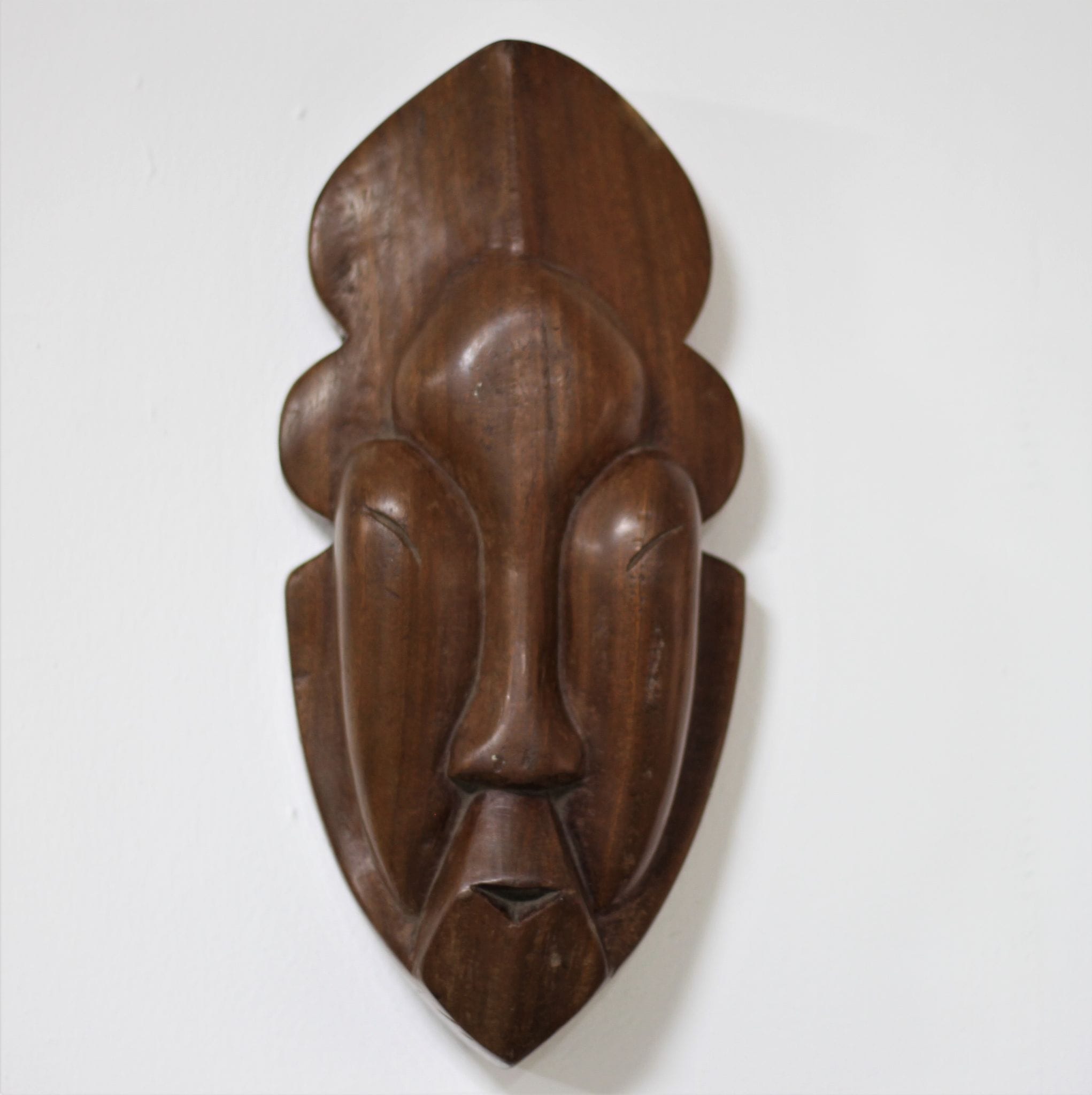
PERSONAL DECORATION AND JEWELRY
African personal decoration and jewelry are also important forms of art that are used to communicate social status and identity. They are often made using materials such as beads, shells, and bone, and are used to adorn the body in a variety of ways. African jewelry often incorporates cultural and religious symbols and is used to communicate important messages.
Overall, African art is a reflection of the continent's rich cultural heritage and complex history. The different forms of African art are deeply rooted in African culture and are used to communicate important cultural and religious ideas. Understanding the different forms of African art is essential for gaining a deeper appreciation of the continent's diverse and complex history.
THE PRECOLONIAL STATUS OF AFRICAN ART
NO SEPARATION BETWEEN FINE ART AND CRAFT
In many African societies, there was no clear distinction between fine art and craft. Artistic expression was often integrated into daily life, and many objects had both practical and aesthetic functions. For example, a beautifully decorated pot might be used for cooking or storing water, while also serving as a form of artistic expression.
Furthermore, the production of art was often a communal activity, involving many members of the community. This meant that there was no clear division between artists and non-artists. Everyone had the potential to create art, and artistic expression was seen as a vital part of everyday life.
UNDERSTANDING LOCAL AESTHETIC VALUES
African art is incredibly diverse, with different regions and cultures having their own unique styles and aesthetic values. Understanding these local aesthetic values is crucial to understanding the historical and cultural significance of African art.
For example, in many West African cultures, masks are an important form of artistic expression. These masks are often used in religious ceremonies, and are believed to have spiritual power. In contrast, in many East African cultures, textiles are a more important form of artistic expression, with elaborate patterns and designs often used to convey social status and identity.
By understanding the local aesthetic values of different regions and cultures, we can gain a deeper appreciation of the historical and cultural significance of African art. This helps us to move beyond a simplistic view of African art as simply exotic or primitive, and to recognize the richness and complexity of artistic expression across the continent.
MISCONCEPTIONS ABOUT AFRICAN ART
Despite the rich history and cultural significance of African art, there are several common misconceptions about it that persist today. Here are two of the most prevalent misconceptions about African art:
NOT JUST MASKS
One of the most persistent misconceptions about African art is that it is only made up of masks. While masks are certainly an important part of African art, they are just one of many forms that African art takes. As we discussed earlier, African art can take the form of sculpture, painting, pottery, rock art, textiles, and personal decoration and jewelry.
Furthermore, masks themselves have many different meanings and functions in African cultures. They can be used for religious rituals, social events, and performances, and they can represent a wide range of concepts, including ancestors, spirits, animals, and mythical beings. Therefore, it is important to recognize the diversity and complexity of African art beyond just masks.
NOT SOLELY CREATED FOR ART'S SAKE IN THE WESTERN TRADITION
Another common misconception about African art is that it is solely created for art's sake in the Western tradition. In other words, it is often assumed that African art is made purely for aesthetic purposes, without any practical or functional value.
However, this assumption is simply not true. In many African cultures, art is deeply intertwined with everyday life, and serves practical purposes as well as aesthetic ones. For example, pottery and textiles are often created for utilitarian purposes, such as carrying water or storing food.
Additionally, personal decoration and jewelry can serve as status symbols, indicating an individual's wealth, social status, or religious affiliation.
Therefore, it is important to recognize that African art is not just a product of the Western art tradition, and that its creation and use is deeply rooted in African cultures and traditions. By understanding the practical and functional aspects of African art, we can gain a deeper appreciation for its significance and value
AFRICAN ART DEBATE: 'ART' OR 'CRAFT'?
African art has long been debated as to whether it should be classified as 'art' or 'craft.' The Western concept of art has often been used to categorize African art, but this approach is problematic. African art is often functional, serving specific purposes beyond mere aesthetic pleasure. For example, many masks and sculptures have ceremonial and religious purposes and are not created solely for art's sake.
One way to understand the status of African art is to recognize that there was no separation between fine art and craft in precolonial African societies. African art was integrated into everyday life, and there was little distinction between the artist, the artisan, and the user of the object. This differs from the Western tradition where art is often created for its own sake and is valued primarily for its aesthetic qualities.
It is important to recognize the functional purpose of African art and to appreciate the cultural significance of each piece. African art is not merely decorative but is deeply embedded in the social, economic, and religious practices of African communities.
Additionally, it is crucial to recognize African artists individually rather than grouping them together as a single entity. African artists come from diverse backgrounds, each with their own unique styles, techniques, and cultural influences. Recognizing the individuality of African artists helps to move beyond simplistic categorizations of African art as solely 'craft' or 'functional object.'
In conclusion, the debate over whether African art should be considered 'art' or 'craft' reflects a Western-centric perspective that fails to appreciate the cultural and historical significance of African art. Recognizing the functional purpose of African art and the individuality of African artists is essential to fully appreciate the richness and complexity of African artistic traditions.
UNIFYING CHARACTERISTICS OF AFRICAN ART
African art is diverse and complex, with a range of styles and forms that reflect the continent's rich cultural heritage. Despite this diversity, there are certain unifying characteristics that can be identified across many different types of African art. These include innovation of form, emphasis on function, and a connection to a higher spiritual world.
INNOVATION OF FORM
One of the most striking aspects of African art is the incredible variety of forms it takes. From the towering wooden sculptures of the Senufo people in West Africa to the delicate beadwork of the Maasai in East Africa, African artists have demonstrated a remarkable capacity for innovation and experimentation.
Part of this innovation comes from a willingness to incorporate new materials and techniques into traditional art forms. For example, the Yoruba people of Nigeria have a long tradition of bronze casting, but in the 20th century, they began to experiment with new materials like aluminum and plastic. Similarly, the Kuba people of Central Africa have long used raffia fibers to create intricate textiles, but in recent years, they have begun to incorporate other materials like synthetic dyes and even recycled plastic bags.
EMPHASIS ON FUNCTION
Another key characteristic of African art is its emphasis on function. Unlike Western art, which is often created for purely aesthetic reasons, African art is often designed to serve a specific purpose, whether that be religious, social, or political. Masks and other ceremonial objects, for example, are often created for use in specific rituals or performances, while textiles and other decorative arts may be used to convey social status or identity.
This emphasis on function does not mean that African art is devoid of aesthetic value, however. Rather, it simply means that aesthetics are often intertwined with practical considerations. For example, a Yoruba bronze sculpture of a king may be valued for its artistic merit, but it is also valued for its role in affirming the king's power and authority.
CONNECTION TO A HIGHER SPIRITUAL WORLD
Finally, many forms of African art are characterized by a deep connection to a higher spiritual world. This can be seen in the many masks, statues, and other objects that are created as part of religious rituals and ceremonies. For example, the Dan people of Liberia and Cote d'Ivoire create masks that are believed to embody the spirits of their ancestors, while the Dogon people of Mali carve intricate wooden figures that represent the spiritual forces that govern the universe.
This connection to the spiritual realm is not limited to traditional forms of African art, either. Many contemporary African artists continue to explore themes related to spirituality and religion, even as they experiment with new materials and techniques. For example, the South African artist Marlene Dumas often creates paintings that explore the intersections of religion, politics, and identity in contemporary African society.
Overall, African art is a complex and multifaceted field, with a rich history and diverse range of forms and styles. Whether exploring traditional sculptures and masks or contemporary paintings and textiles, understanding the unifying characteristics of African art can help us to appreciate the deep cultural significance of this remarkable artistic tradition.
AFRICAN TRIBAL ART IN SOCIAL CONTEXT
African tribal art holds a wealth of symbolism that is closely tied to the social and cultural context in which it is created. The meaning behind these symbols is deeply rooted in the religious, political, and social beliefs of the communities in which they were produced.
For example, the use of certain animals or motifs in African sculptures can convey messages about power, status, or the relationship between humans and the natural world. The use of abstract or geometric forms may represent the spiritual or supernatural realm, while the depiction of everyday objects and scenes may represent everyday life.
Understanding the societal structure of African communities is crucial to interpreting the meaning behind these symbols. In many African societies, art was not produced by individuals working alone, but rather by groups of artists who were closely connected to their communities. This close connection allowed artists to create works that were not only aesthetically pleasing, but also socially and politically relevant.
African art also often reflects the hierarchical nature of African societies, with certain styles or forms reserved for use by individuals of particular status or rank. For example, in some societies, only kings or chiefs were allowed to commission certain types of art, while in others, art was used as a means of demonstrating wealth or social status.
In addition to its social significance, African tribal art also played an important role in religious and spiritual life. Many African societies believed that art had the power to connect humans to the spiritual realm and to their ancestors, and that the creation of art was a way of communicating with these higher powers.
Overall, understanding the social context in which African tribal art was created is essential to fully appreciating its meaning and significance. By recognizing the connections between African art, society, and spirituality, we can gain a deeper understanding of the rich cultural heritage of this continent.
TYPES OF AFRICAN ART
African art encompasses a vast range of art forms, styles, and traditions. In this section, we will explore some of the different types of African art.
PREHISTORIC ROCK ART
The oldest examples of African art are found in the form of rock art. This type of art is found across the continent, and its origins date back over 5,000 years. These ancient rock paintings and engravings depict a range of subjects, including animals, people, and abstract designs. Many of these artworks are associated with spiritual and religious beliefs and were created for ritualistic purposes.
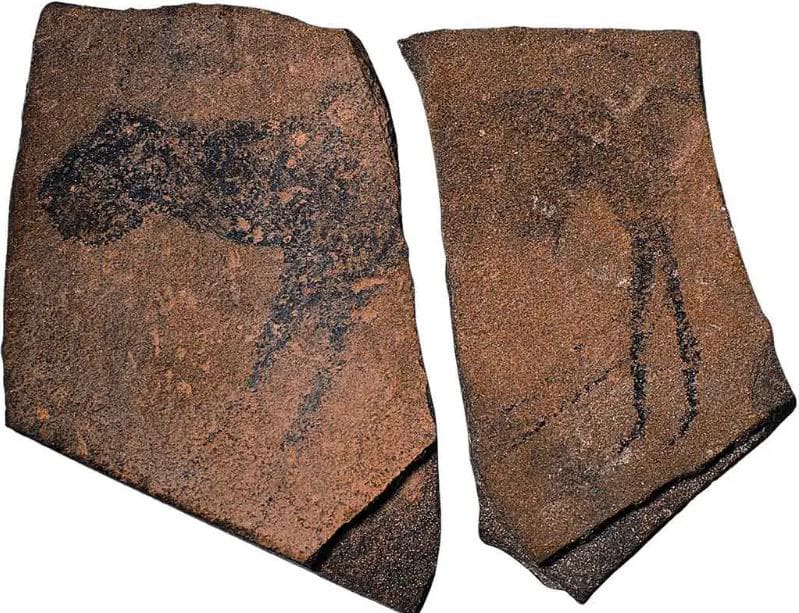
CLASSICAL AFRICAN SCULPTURE
Classical African sculpture is a term used to describe the figurative sculpture produced by the civilizations of ancient Africa. These sculptures were created between 500 BCE and 1500 CE and represent some of the most significant artistic achievements in African history. Classical African sculpture is known for its expressive and powerful forms, which often depicted kings, queens, and other members of the royal court.
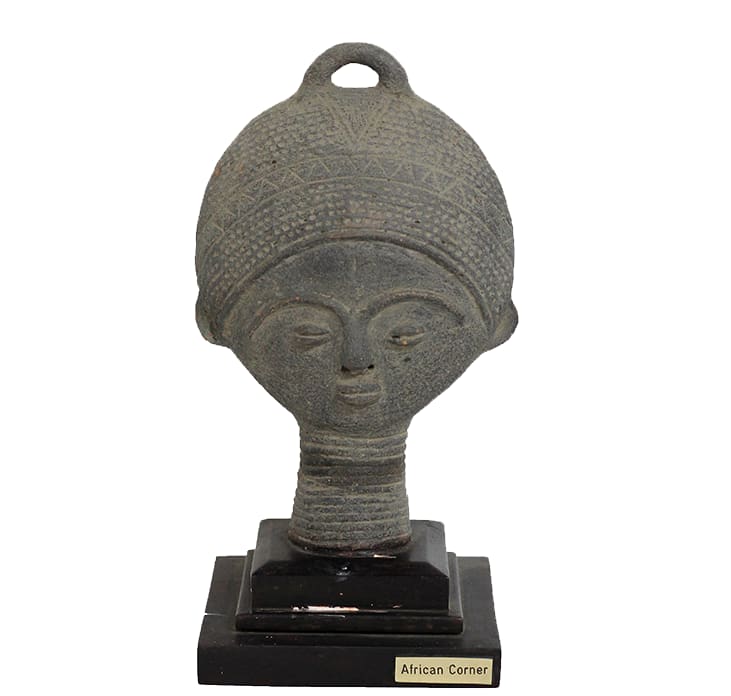
WOODEN SCULPTURE
Wooden sculptures are one of the most recognizable types of African art. These sculptures are typically carved from a single piece of wood and range in size from small figurines to life-size representations. Wooden sculptures were created for both practical and ceremonial purposes and were often used as fertility charms, ancestor figures, or objects of spiritual significance.
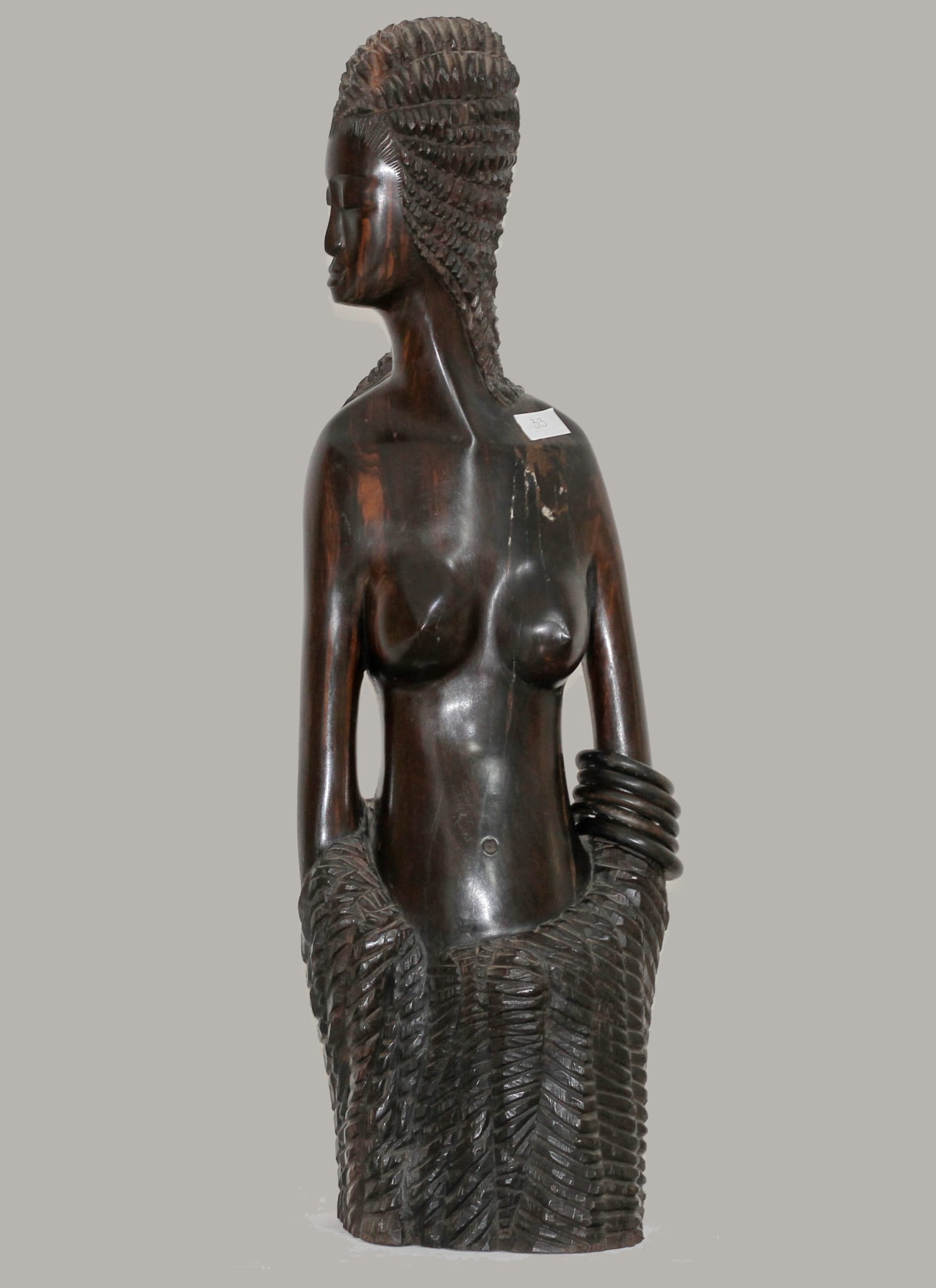
ART OF THE AFRICAN KINGDOMS
The art of the African kingdoms refers to the art produced by the various kingdoms and empires that existed across the continent. These artworks were created for a range of purposes, including religious, political, and social. The art of the African kingdoms is known for its intricate designs and detailed craftsmanship, which often featured symbolic representations of power, authority, and wealth.

KUBA-BUSHONG ART
Kuba-Bushong art is a term used to describe the art produced by the Kuba people of the Democratic Republic of Congo. This art is known for its intricate patterns and designs, which are often created using a combination of weaving, embroidery, and applique techniques. Kuba-Bushong art is highly prized for its aesthetic beauty and is often used in ceremonial contexts, such as funerals and initiation ceremonies.
SECRET SOCIETIES MASK ART
Secret societies mask art is a type of African art that is associated with various secret societies and initiation rites. These masks are typically made from wood, and their designs often incorporate a range of symbols and motifs that are specific to the society in question. The masks are used in a variety of contexts, including healing, hunting, and funerary rites.
RELIGIOUS ART
Religious art is a broad category of African art that encompasses a range of different styles and forms. This art is typically associated with various religious beliefs and practices, such as animism, Islam, and Christianity. Religious art often features symbolic representations of the divine, as well as depictions of various religious figures and stories.
ART OF WITCHCRAFT
Art of witchcraft is a type of African art that is associated with various forms of witchcraft and sorcery. This art often features depictions of spirits, witches, and other supernatural entities, and is used in a range of different contexts, including divination and healing.
ART FOR ART'S SAKE
Finally, African art for art's sake is a type of art that is created purely for aesthetic purposes. This art is often characterized by its innovative designs and use of materials, and it is highly prized for its aesthetic beauty. African art for art's sake is often created by individual artists who are recognized for their unique styles and contributions to the artistic tradition.
ANCIENT CIVILIZATIONS OF AFRICA AND OTHER CONTINENTS
African art has been an important part of the continent's cultural and historical identity for thousands of years. It has been created by various ancient civilizations, including the Nubians, Egyptians, and Ethiopians, who left behind magnificent pieces of art that continue to fascinate people today. African art has also influenced other continents, with evidence of its impact found in the art of ancient Greece and Rome, as well as in modern art movements such as cubism and fauvism.
The aesthetic appeal of African art lies in its bold forms, striking use of color, and incorporation of symbols and motifs that hold cultural and spiritual significance. Many African artworks were created for functional purposes, such as in religious or ceremonial contexts, but their beauty and craftsmanship have also made them highly valued and sought after by collectors and museums around the world.
The influence of ancient African art can be seen in many contemporary art forms as well, with African artists continuing to explore and push the boundaries of their traditional techniques and styles. The appreciation and understanding of African art is crucial to gaining a deeper understanding of the continent's diverse cultural heritage and history.
PREHISTORIC ROCK ART OF AFRICA
Yellow-skinned Bushmen as the oldest known natives of South Africa
The prehistoric rock art of Africa is a fascinating subject that has captured the attention of archaeologists, anthropologists, and art historians for many years. Rock art refers to images or designs that are painted or carved onto natural rock surfaces. These images can provide insights into the lives and beliefs of prehistoric people and their cultures.
The oldest known inhabitants of South Africa were the San people, also known as the Bushmen. They are believed to have been in the region for over 25,000 years and have left behind an extensive collection of rock art that has been found throughout the country. The Bushmen were known for their hunting and gathering lifestyle and were skilled in the use of natural resources to survive in the harsh environments of Southern Africa.
The rock art of the Bushmen is particularly notable for its vibrant colors and intricate designs. The paintings depict animals, humans, and various shapes and symbols that are thought to have held significant meaning to the Bushmen. The paintings were created using natural pigments made from minerals such as ochre, charcoal, and blood, and were often applied to the rock surface using a brush made from animal hair.
The rock art of the Bushmen can be found in many different locations throughout Southern Africa, including the Drakensberg Mountains in South Africa, the Matobo Hills in Zimbabwe, and the Tsodilo Hills in Botswana. These sites have been designated as UNESCO World Heritage Sites due to their cultural and historical significance.
The rock art of the Bushmen is just one example of the rich history and cultural heritage of Africa. It provides a glimpse into the lives and beliefs of prehistoric people and their connection to the natural world. By studying this art form, we can gain a better understanding of the evolution of human society and the role that art has played in shaping our cultural identity.
EXHIBIT AT THE AFRICAN ART MUSEUM
The National Museum of African Art in Washington, D.C. is home to a number of fascinating exhibits showcasing the rich cultural heritage of Africa. One of such exhibit is "From the Deep: In the Wake of Drexciya with Ayana V. Jackson."
The exhibit centers around the mythology of Drexciya, an underwater kingdom created by James Stinson and Gerald Donald, two Detroit-based musicians. According to the mythology, Drexciya was founded by pregnant African women who were thrown off slave ships into the Atlantic Ocean. Their children, born underwater, formed a new society in which they could be free from the oppression of their captors.
Ayana V. Jackson, an artist and photographer, explores this mythology through a feminist lens, highlighting the powerful, resilient women who created Drexciya. She also draws connections between the mythological kingdom and the traditional beliefs of African cultures, particularly those related to water spirits.One of the key themes of the exhibit is the idea of a sacred aquatopia, a world in which women are able to thrive and assert their power. Jackson uses her art to envision this world, using powerful images of black women to explore the possibilities of a society in which they are truly free.
At the same time, the exhibit does not shy away from the brutal history of the slave trade. Rather, it reckons with this history, using the mythology of Drexciya to explore the trauma and pain of those who were forced into bondage. In doing so, it provides a powerful commentary on the ongoing legacy of slavery and the ways in which contemporary artists are grappling with this legacy.
Overall, "From the Deep: In the Wake of Drexciya with Ayana V. Jackson" is a thought-provoking and visually stunning exhibit that showcases the power of African mythology and the resilience of African women. It is a testament to the enduring importance of African art and culture, and a reminder of the ongoing struggle for justice and equality.
FAQ's
1. What is African art?
A: African art refers to the traditional art forms, crafts, and visual expressions produced by the indigenous people of Africa.
-
What are the different forms of African art?
A: African art includes sculpture, painting, pottery, rock art, textiles, masks, personal decoration, and jewelry.
-
What is the historical and cultural significance of African art?
A: African art has played a vital role in the cultural and historical identity of African communities. It has been used to communicate social, political, and spiritual messages, and has served as a medium for preserving cultural traditions and beliefs.
-
What are some misconceptions about African art?
A: One common misconception is that African art only refers to masks. Another is that African art is solely created for art's sake in the Western tradition, when in reality it has always had a functional purpose in African societies.
-
Is African art considered "art" or "craft"?
A: There is ongoing debate over whether African art should be considered "art" or "craft," as it often has a functional purpose and is created by a community rather than an individual artist. However, many contemporary scholars and artists recognize African art as a unique form of artistic expression.
-
What are some unifying characteristics of African art?
A: Some unifying characteristics of African art include innovation of form, emphasis on function, and connection to a higher spiritual world.
-
What is the meaning behind symbols in African sculptures and other art forms?
A: Symbols in African art often have deep cultural and spiritual meanings that vary between communities and regions. They may represent social status, fertility, protection, or other aspects of the community's identity.
-
What is the aesthetic appeal of African art?
A: African art is known for its bold use of color, geometric shapes, and stylized forms. It often reflects the natural world and the community's connection to it.
-
What is prehistoric rock art?
A: Prehistoric rock art refers to the ancient art found on rocks and cave walls throughout Africa. It often depicts animals, hunting scenes, and religious or spiritual symbols.
-
What can we learn from studying African art?
A: By studying African art, we can gain a deeper understanding of African culture, history, and identity. We can also appreciate the unique artistic expressions and traditions of African communities.


